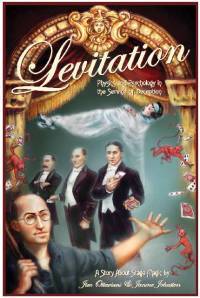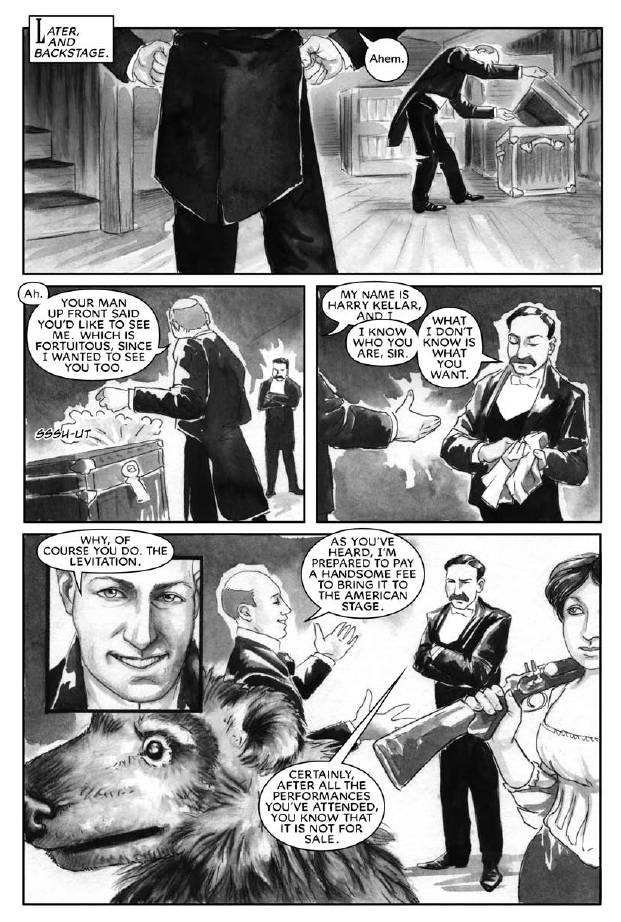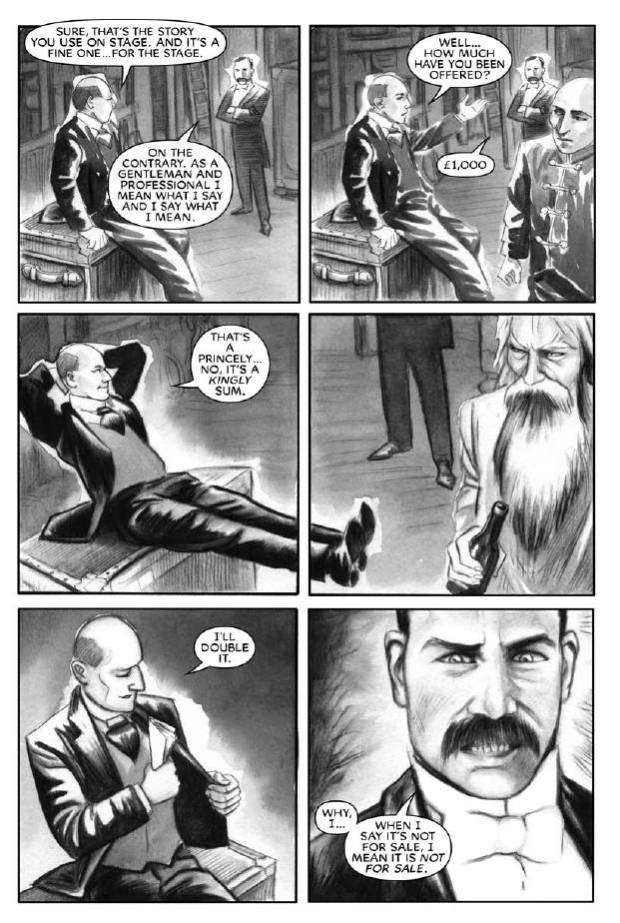 Home > CR Interviews
Home > CR Interviews A Short Interview With Jim Ottaviani, Janine Johnston and Dylan Meconis
posted May 5, 2007
A Short Interview With Jim Ottaviani, Janine Johnston and Dylan Meconis
posted May 5, 2007


*****
I worked with
Jim Ottaviani a decade or so ago when I was editing
The Comics Journal, and have watched his self-publishing efforts at
GT Labs with great interest. Ottaviani not only produces comics in a niche he has all to himself, biographies and historical fiction on science and scientists, but his comics have an understated writer-first feel to them that stands in bold relief against much of today's cartooning landscape.
This summer's
Levitation: Physics and Psychology in the Service of Deception and
Wire Mothers: Harry Harlow and the Science of Love are graphic novellas that tackle splashily non-science subjects in terms of their nuts and bolts particulars.
Levitation manages a consistent tone that facilitates a dispassionate dissection of highly competitive, singularly focused stagecraft.
Wire Mothers starts in vigorous, messy fashion before cohering into an intimate portrait of the emotional and personal costs of a life devoted to scientific research. I was happy to talk to Jim and his latest co-contributors,
Janine Johnston (
Levitation) and
Dylan Meconis (
Wire Mothers). With book projects on the way for
First Second and Simon and Schuster, it may be Ottaviani's last foray into traditional comics self-publishing for a time. Following the brief chat with the creators are chunks of each book for preview purposes.
*****
 TOM SPURGEON: Jim, can you give us an update on the status of GT Labs and where these two books can be placed in your company's development? Are these the last two before you begin work for First Second?
JIM OTTAVIANI:
TOM SPURGEON: Jim, can you give us an update on the status of GT Labs and where these two books can be placed in your company's development? Are these the last two before you begin work for First Second?
JIM OTTAVIANI: That work has already begun, as I've already written the first of the books for First Second and am over half-way through a draft of the second one. So the timing here is, to some degree, coincidental. But these may well be the last two books that come out from G.T. Labs for a while, since after the ones for Mark Siegel and co. I have another book to write for one of
Simon & Schuster's imprints. The stacks of reference books in my office have reached never-before-seen levels.
SPURGEON: Are you going to continue with self-published original graphic novels? Why are these books being published at the same time?
OTTAVIANI: I intend to continue publishing through G.T. Labs. Putting out these two books simultaneously is part of a plan that will allow me to continue to both self-publish and work for others.
You noticed that these two stories are shorter than my most recent graphic novels. You didn't notice the spines, because I didn't send them to you. They have numbers on them, and that's because once I had written these books I realized that I had the beginnings of a series of graphic novels -- novellas, if you prefer -- on the science of the unscientific. My previous books, and the ones coming out from the other publishers, are long works on obviously scientific topics. But when people think of love, or magic, they don't think science. Books on religion and art and who knows what else will follow in time, if all goes well.
SPURGEON: What kind of communication exists between you and your artists in terms of the technical explanation aspect of your books? How much do you breakdown how to explain the levitation trick for example, and how much is left to the artist to stage that kind of dense, informative sequence?
OTTAVIANI: For the levitation trick, I needed to break it down and draw it myself in some detail so
I could understand it. Once I'd done that, there was no reason not to share my drawings with Janine [Johnston], so I did.
JOHNSTON: Still, every so often I would send Jim these emails of "Help!! I have no idea what I'm drawing!" Would've helped buying a darn hoop for reference photos instead of trying to figure things out with a partially inflated inner tube...
OTTAVIANI: Yeah, that might have made it easier! So even though I'd done some detailed breakdowns of some of the aspects in schematic form, we still had to talk some things through to make things clear. I do the thumbnails for myself, really, but having done them I share them as a way to jump-start the process on those occasions when that's helpful. But as Janine says, sometimes those drawings only make sense to me.
DYLAN MECONIS: For
Wire Mothers Jim provided me with a lot of excellent source material to work from, both photos and text -- the best of all being a CD with the actual television special, the "rehearsal" for which serves as an excuse for the narrative of
Wire Mothers. I've actually had coursework in primate studies, so I went in with a good background to understand the experiments
[Harry F.] Harlow was running and where to learn more about them.
I did some research on my own, for example on the workings of the infamous "
Skinner box," and it was fun to give accurate representations of things to Jim which he hadn't initially given me on a platter.
 SPURGEON: How much research and double-checking in terms of making these books accurate historically and visually? Is there an example of something that you had to track down in order to depict something in one of these two books?
JOHNSTON:
SPURGEON: How much research and double-checking in terms of making these books accurate historically and visually? Is there an example of something that you had to track down in order to depict something in one of these two books?
JOHNSTON: I was constantly using Google image -- even down to odd little things like
steak and kidney pie, which, never having had it, really didn't know quite what it looked like. But there was lots of the obvious subject matter like carriages, theatres and historical costume to research on top of the actual characters and the levitation itself. Very very thankful for Google image actually... it's made things much easier! I still ended up using the library a lot, too, though. Jim of course sent pages and pages on the magicians and the trick, but there was no shortage of other things to look up.
It would be nice to be less dependent on reference, but I'm a bit of a stickler for trying to keep things "right." I kept imagining experienced card-handlers looking at the shots of Thurston "scaling" and saying, "That's not how you hold 'em..."
OTTAVIANI: Didn't I send you some reference from
Ricky Jay's fabulous book
Cards as Weapons? I can't remember...it took me a long while to get a copy myself, so maybe not.
JOHNSTON: No, but I found one called
Paul Daniels' Adult Magic in the last couple of weeks before I finished, useful for two of the shots anyhow. They had just put it on the shelf that day at one of the second hand bookstores I check in. Wish I'd found it earlier though!! Otherwise, I used stuff I found online.
... I have that kind of thought run through my head a lot when it comes to being historically accurate, especially with hand things like holding swords and martial art positions... and cards!
MECONIS: A good number of the environments were provided for us in photograph form --
the exterior of Goon Park, although it's since been demolished, was photographed, and the feel of the labs on the inside is preserved in the television special.
Finding information on the World's Fair that's depicted in the book was tricky -- there isn't much readily available photographic evidence for what things looked like, so we both gleaned what we could, and made up the rest. There was one decent photograph of the exterior of the pavilion that housed the baby incubation exhibit, and a few grainy ones of the harbor area; the poster for that year's fair is still a popular art print.
Strangely enough, it was very easy to find photos from
Sally Rand's basically-nude "Bubble Dance" routine online.
Other elements were almost entirely guesswork, or amalgams from other sources. The trick with historical fiction in comics is to find what you can and reproduce it faithfully where it won't hinder the story; and commit absolutely to the incidental details you're totally making up.
OTTAVIANI: I think that's exactly right. It's like the old saying about something looking, walking, and quacking like a duck. The reader will believe it's a duck, even if it's some other kind of water fowl, and that's what's most important -- to keep the reader in the story.
SPURGEON: What attracted you to doing a project about the science of magic and love? Is there something behind the delicious hook that resonates with you?
OTTAVIANI: The hook -- science of the unscientific -- is compelling to me. But sure, there's more to it than a tagline.
As for magic, the story within the story within the story aspect attracted me. And what makes the tricks go is science since there is no such thing as magic on stage. It's physics, it's psychology. My favorite magicians,
Penn and Teller, put it best in their essay "Why We Suck on TV": "We don't want any willing suspension of disbelief from you, no way. Save your slack for Shakespeare. We want you to look critically and intelligently and still see things you can't explain. And we like the rules of live theater, because they're the rules of the universe. The rules of live theater are the rules you've been living with since you were born. That's the physics; the time/space reality we want for our playing field."
Regarding love, well, the fact that we love is almost magical, isn't it? Almost. Because of that ambiguity, there was a period where scientists came close to convincing each other that it didn't exist. Fortunately, most civilians -- moms and dads and wives and husbands and brothers and sisters and so on -- weren't paying much attention to that nonsense. And equally good, a few other scientists knew this was nonsense as well, and set about proving that love exists, it's learned, and it matters.
SPURGEON: What would you have the reader take away from the subtext in the Harry Harlow story about his own personal relationships?
OTTAVIANI: The facile lesson is "those who can't do, teach," but I don't think that's all there is to it, otherwise the story wouldn't hold your interest.
Harlow's continued search to find out how and why his life and relationships worked the way they did are universal. Unlike most of us, though, his discoveries happened largely in the lab. Yours and mine happen in real life. That the lessons he learned didn't cross over very well for him, just like you and I can't convert our life lessons into universal scientific principles, says something about what it is to be human. So the things that made Harlow a good scientist, one interested in and capable of finding out what love means, weren't traits that helped him address problems in his personal life. For some reason I take some comfort and learn from that, and I hope readers will too.
 MECONIS:
MECONIS: I think it's because we're all fascinated by the things which trouble us the most in our own lives. Even through secondhand sources and at decades' remove, you can tell that Harlow was a man who had a rotten childhood, and knew it, but didn't have the equipment to fix himself. As a result, I don't think he had a very good understanding of how love, in its healthiest form, actually operates in daily life. He was a difficult husband and a distant father, and no doubt a totally maddening scientific colleague.
So he took the stuff he
was comfortable with, the scientific process, and turned it like a firehose onto the subject of love. The results are fittingly powerful and contradictory -- a set of horrendously chilling experiments which incontrovertibly demonstrated one of the most tender principles of human life.
SPURGEON: How important is it for each book to have a distinctive look; is design an important factor when it comes to making one of these works, or are you more heavily focused on serving the narrative?
OTTAVIANI: It's not an either/or thing. I can't indulge every whim, or even every good idea, since the finishes book has to be manufactured in large quantities, and that means dealing with printing processes and budgets. But since the story is she who must be obeyed, the finished pages set the tone for the overall look and feel of the finished book.
MECONIS: The narrative was really the focus. I read the script and put together a style that was pretty divorced from things I'd done previously, so that it would match up. It's a stark, mid-century story full of emotional alienation, so it needed a certain amount of realism -- solid in settings, but emotionally flexible for the characters -- a contrast in light and dark, and to be at least a little cinematic. I had to learn how to work in black and white, and at that degree of realism, as I went. It was terrifying.
And pretty much the whole way through, Jim liked what I showed him, so we just ran with it. Every comment was about storytelling, rather than polish or style, which is a value the two of us share.
*****


 Levitation: Physics and Psychology in the Service of Deception
Levitation: Physics and Psychology in the Service of Deception, Jim Ottaviani and Janine Johnston, GT Labs, softcover, 72 pages, 9780978803704 (ISBN13), July 2007, $12.95.
*****



 Wire Mothers: Harry Harlow and the Science of Love
Wire Mothers: Harry Harlow and the Science of Love, Jim Ottaviani and Dylan Meconis, GT Labs, softcover, 88 pages, 9780978803711 (ISBN13), July 2007, $12.95.


